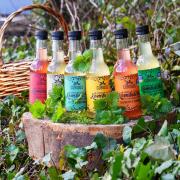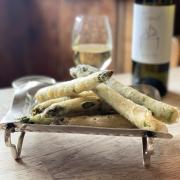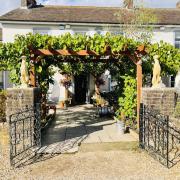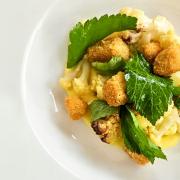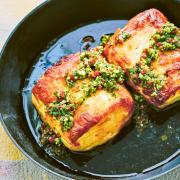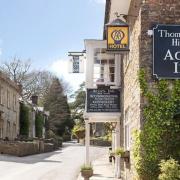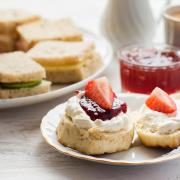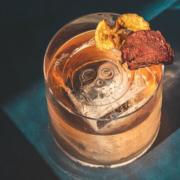Cider pomologist Liz Copas and cider maker Nick Poole have scoured the county for long forgotten cider apple varieties such as Golden Ball, Ironside and Cattistock Pink Their finds are now growing in Linden Lea Orchard, Melplash and producing cider.
If you are passing through Melplash on your way to Bridport in springtime, you might get a tantalising glimpse of pink apple blossom in the centre of the village. This is Linden Lea, a very Dorset orchard, full of unique lost and found again cider apple trees. Linden Lea is very special to me since it represents 10 years of searching for old apple trees in forgotten corners of Dorset with my cidermaking friend Nick Poole from West Milton near Bridport.
In mid-May when the sun is shining, the orchard greets you with the perfume of 50 or more trees in full bloom, with names like Golly Knapp, Dewbit, Buttery Door, Marnhull Mill, Puddletown, Sweet Alford and Lancombe. Their froth of pink and white blossom is always buzzing with all manner of pollinating insects. In the summer months, the orchard is mysteriously dark and green as it prepares for the autumn crescendo of glossy, colourful ripening fruit, full of interesting flavour and plenty of sugar. This is the time that cider lovers like Nick and I are most interested in.

When Nick started making cider seriously about 20 years ago (he set up the West Milton Cider Co. with his wife Dawn), he found true Dorset cider apples hard to source. The cider club that he had started was burgeoning, but all they could only find to use were garden apples, eaters and cookers. Good for starters but not the true traditional flavour of cider.
Once, Dorset had over 10,000 acres of farm orchards. Not that long ago they were an essential part of traditional farming life across the county, there to provide cider for those who worked on the farm. And it had to be good, for if the farm lost its reputation for good cider, the workers would leave to find one where it tasted better. But times have changed, and, like all Westcountry counties, Dorset has lost nearly all its farm orchards over the last 100 years.
In the hope of finding what sort of cider Dorset people would have drunk a century ago, in 2007, Nick and I set out to find any orchards that might have been spared and see if we could rediscover some traditional cider apples. We found little signs of the once burgeoning farm orchards. However, after several years of searching all over Dorset we did unearth a handful of promising, forgotten, nameless old trees, mostly in the corners of fields and even in back gardens of new houses.
Finding the original cider apple names was difficult. I searched many books and archives but with little result. Not much has ever been written about Dorset’s orchards, what sort of trees they grew or what apples went into their cider. I did find a reference to Symes Seedling, a handsome red striped apple we sourced in an old orchard in Powerstock. It was a popular dessert apple in the 1920s, raised by a Mr Symes in Loders.

Then, by lucky chance, I came across a scrappy page of pencil written notes about some local cider apple varieties, including their specific flavour attributes, made back in the 1930s by a Mr Phillips Pickford. He was employed by the Cider Institute at Long Ashton near Bristol (created in 1903 to improve the West Country cider industry) to travel around the Westcountry as a Cider Instructor, advising farmers on the best, most modern ways to improve the quality of their cider. Farm cider did have a pretty poor reputation in those days. An infusion of technical advice was desperately needed to raise it from ‘haymaking’ to a marketable product if farmers were hoping to make a profit from selling it.
Mr Pickford’s page gave us a list of Dorset varieties with brief description of their apples. Not a lot to go on but at least we could put names to Golden Ball, Kings Favourite, Buttery Door, and Ironsides - the tough green apple that keeps for a year. Pickford’s cidermaking tuition seems to have paid off, for Netherbury cidermaker Harry Warren began winning national prizes with his Golden Ball cider. He soon joined forces with other local growers to launch the Linden Lea cider company, selling bottled and carbonated cider until the 1960s. Now, some of the apple varieties that they might have used are growing once again in our Linden Lea Orchard nearby in Melplash.


To move this project forward, we needed to find out more about our other discoveries. I was the last cider pomologist employed by the Long Ashton Reseach Centre; it closed its doors after 100 years in 2003. Due to my experience in this area, I was able to join the DNA research work that had been started by the National Fruit collection at Brogdale in Kent. (fruitid.com). If our rediscovered trees were known varieties, already in their collection of many thousands of trees, their DNA would match one on their data base, and their identity be revealed. All we had to do was pick a few leaves from each apple tree and send them to their laboratory in Kent. It took nearly a year for the results to emerge, only to find that all but three of our 27 finds were unknown, not found in any collection and never previously recorded. Clearly ours were genuine cider apples unique to Dorset, and since their original names were lost, we found them some new Dorset names to register them in the National Apple Collection such as Marlpits, named after the farm where it was discovered.
Our unique finds will also contribute some useful forgotten genes to the apple genetic pool. Golden Ball, aka Neverblight, not only makes excellent cider but never suffers from leaf diseases. A genetic make-up that could be so useful for breeding new apple varieties in the future.

The next bit of research was a lot easier to do, and very pleasant. We needed to make some cider. All our apple finds are full of distinctive character, some sharp tasting, some sweet, others as sour and bitter as crab apples. A wide selection of flavours that would have suited the individual tastes on farms and in the villages where we found them. The proof would be in the tasting. So, in the autumn of 2019, when our young trees had their first big crop, Nick and I picked up enough apples to press and make single variety ciders. But would they make good cider? We waited until the following April before we tasted them, allowing time for their flavours to develop. Quietly pleased, we invited many cidermakers and cider-loving friends to come to a tasting and make their appraisal of our single variety ciders.
Symes Seedling has proved to be a first class find. Apples good to eat, crisp and fresh from the tree. It makes a lovely light and fruity cider with an almost wine-like quality. We gave it 8/10 for drinkability at our tasting. No wonder it used to be popular years ago.

Tom Legg is another top ten variety that makes a light, quite floral tasting cider with low astringency. An easy drinking style of cider that is so popular commercially these days.
Marlpits is Nick’s favourite, taken from an old tree growing on the farm next to his cider barn. It too makes a smooth, well-mannered cider with a hint of apricot. What good taste the farmer had to choose it for his little orchard all those years ago!
Frome River is one of my favourites, rescued from an old orchard in Maiden Newton before it was grubbed up. Our young Frome River trees would be useful additions to any orchard. Their bright red, bittersweet fruit makes dark, slightly pink cider full of tannin. What a find!

Another in the top 10, Matravers, came from a lone tree in Uploders near Bridport, not that far from the site of the old Norman priory. There is a legend, believed by many people of West Dorset, that this was where cider was first made in England, by French monks, and using fruit from cider apple trees that they brought with them from Brittany before the Norman Conquest. Could Matravers be a descendant of one of the trees that the Breton monks grew? Its DNA suggests it could be related - very distantly. Every year the ground beneath our Melplash trees is carpeted with small, round, orange red apples. The cider the Matravers apples make is certainly good, quite light and easy to drink, with a fruity flavour that should appeal even to modern English taste.
Dorset Winter Stubbard’s trees grow disappointingly poorly, but they are worth a little patience, for their knobbly green apples make one of the best tasting ciders, 8/10 in our taste test.

For those who like an old-fashioned farmhouse taste, the dark rose coloured Cattistock Pink cider apple is for them. Some of the other single variety ciders are a little more challenging. If you like a citrus flavour, then Tangy is for you and interesting enough to be in my top ten. Hunters Ground, the last surviving tree in Cattistock’s orchard, has a wonderful, full blend of sharpness and tannins. It is sad that there is no one left in the village who still makes cider!
However, Golden Ball, the apple that made Harry Warren’s cider a prize winner nearly 100 years ago, won the greatest praise at our tasting event. It produced a well-balanced cider, pale straw in colour with notes of honey and a light floral background. A firm 9/10.


Others sampled included: Yaffle which has a slight hint of liquorice; Lancombe and Cap of Liberty, both dry and astringent, better used in a blend; Haines Sweet, easy drinking wine-like quality with a buttery feel; and Golly Knapp which had long dryness on the tongue.
The good news is that many of our old varieties have begun a new life in gardens and cider orchards around Dorset, and across the border in both Devon and Somerset. On their own or blended with other apples, they will certainly soon be introducing some interesting new flavours to challenge any unexciting commercial ciders.
Perhaps there are still more old cider apple trees out there waiting to be rediscovered? If you know of any growing in Dorset, we would love to hear from you.
The Lost Orchards: Rediscovering the forgotten cider apples of Dorset by Liz Copas and Nick Poole is published by Little Toller Books at £17 littletoller.co.uk

A Taste of Dorset’s Cider Apples
Grow it: Help support Dorset varieties of cider apple by planting a tree or two in your garden or create a community orchard. Dorset cider apple varieties discovered by Liz Copas and Nick Poole are available from ciderappletrees.co.uk and adamsappletrees.co.uk.
Drink it: Nick Poole makes award-winning Dorset cider in his cider shed at Lancombe Cross, including Dorset Starlight, Purple Haze and Flowery Bottom, as well as Lancombe Rising which uses the keeving method to produce a naturally sweet sparkling cider westmiltoncider.co.uk.









